
Droseraceae is a family of carnivorous flowering plants, also known as the sundew family. It consists of approximately 180 species in three extant genera. Representatives of the Droseraceae are found on all continents except Antarctica.

Drosophyllum is a genus of carnivorous plants containing the single species Drosophyllum lusitanicum, commonly known as Portuguese sundew or dewy pine. In appearance, it is similar to the related genus Drosera, and to the much more distantly related Byblis.
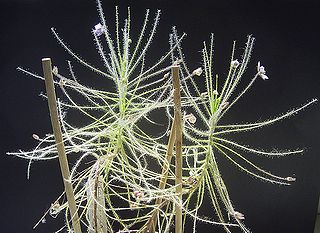
Byblis is a small genus of carnivorous plants, sometimes termed the rainbow plants for the attractive appearance of their mucilage-covered leaves in bright sunshine. Native to Australia and New Guinea, it is the only genus in the family Byblidaceae. The first species in the genus was described by the English botanist Richard Anthony Salisbury in 1808. Eight species are now recognised.

Drosera spatulata, the spoon-leaved sundew, is a variable, rosette-forming sundew with spoon-shaped leaves. The specific epithet is Latin for "spatula shaped," a reference to the form of the leaves. This sundew has a large range and occurs naturally throughout Southeast Asia, southern China and Japan, Micronesia, Papua New Guinea, eastern Australia, Tasmania and New Zealand. Variants are often known by the localities in which they are found. The plant does not form hibernacula in winter, and is easily grown using the same methods as Drosera capensis.

Ancistrocladus is a genus of woody lianas in the monotypic family Ancistrocladaceae. The branches climb by twining other stems or by scrambling with hooked tips. They are found in the tropics of the Old World.

Nepenthes maxima, the great pitcher-plant, is a carnivorous pitcher plant species of the genus Nepenthes. It has a relatively wide distribution covering New Guinea, Sulawesi, and the Maluku Islands. It may also be present on Wowoni Island.
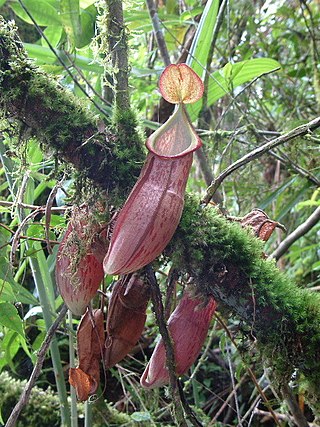
Nepenthes gymnamphora is a tropical pitcher plant native to the Indonesian islands of Java and Sumatra. It has a wide altitudinal range of 600–2,800 metres (2,000–9,200 ft) above sea level. There is much debate surrounding the taxonomic status of this species and the taxa N. pectinata and N. xiphioides.
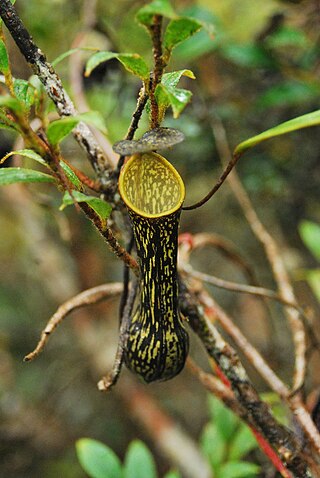
Nepenthes mikei is a tropical pitcher plant endemic to Sumatra. It is characterised by its black mottled lower and upper pitchers. The species is closely related to N. angasanensis and N. tobaica.

Nepenthes thorelii is a tropical pitcher plant endemic to Indochina. Very little is known about N. thorelii and it is unlikely to have entered cultivation, although various other taxa are often mislabelled as this species in the plant trade. Prior to its rediscovery in 2011, N. thorelii was considered possibly extinct, both in the wild and in cultivation.
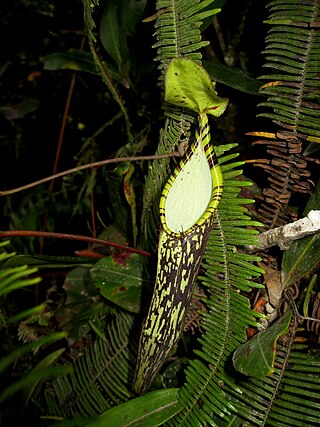
Nepenthes spectabilis is a tropical pitcher plant endemic to Sumatra, where it grows at elevations of between 1400 and 2200 m above sea level. The specific epithet spectabilis is Latin for "visible" or "notable".
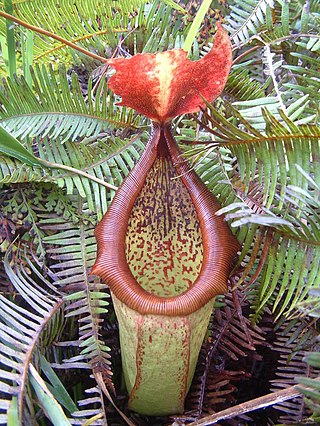
Nepenthes insignis is a tropical pitcher plant endemic to New Guinea and surrounding islands. The specific epithet insignis is Latin for "distinguished" or "remarkable".

Nepenthes × ventrata is a natural hybrid involving N. alata and N. ventricosa. Like its two parent species, it is endemic to the Philippines. The name was originally published in the Carnivorous Plant Newsletter in 1979.

A protocarnivorous plant, according to some definitions, traps and kills insects or other animals but lacks the ability to either directly digest or absorb nutrients from its prey like a carnivorous plant. The morphological adaptations such as sticky trichomes or pitfall traps of protocarnivorous plants parallel the trap structures of confirmed carnivorous plants.

The International Carnivorous Plant Society (ICPS) is a non-profit organization founded in 1972. It is the International Cultivar Registration Authority for carnivorous plants. As of June 2011, the society had around 1400 members. The ICPS publishes a quarterly publication, the Carnivorous Plant Newsletter.
Cassipourea hiotou is a species of plant in the Rhizophoraceae family found in Ivory Coast and Ghana. The species grows naturally in the well-shaded, to wet evergreen forests on the land region lying between the Cavally and Sassandra rivers. Although the extent of these forests has been significantly reduced, it can be locally common.

Carnivorous plants are plants that derive some or most of their nutrients from trapping and consuming animals or protozoans, typically insects and other arthropods, and occasionally small mammals and birds. They still generate all of their energy from photosynthesis. They have adapted to grow in waterlogged sunny places where the soil is thin or poor in nutrients, especially nitrogen, such as acidic bogs. They can be found on all continents except Antarctica, as well as many Pacific islands. In 1875, Charles Darwin published Insectivorous Plants, the first treatise to recognize the significance of carnivory in plants, describing years of painstaking research.

Drosera hamiltonii, the rosy sundew, is a small, compact species in the carnivorous plant genus Drosera and is the only species in the monotypic subgenus Stelogyne. The glandular leaves are about 2 cm (0.8 in) long and arranged in a rosette. In November and December, pink flowers on 30 cm (12 in) tall scapes bloom. It is endemic to coastal swamps in south-west Western Australia. It was first described by Cecil Rollo Payton Andrews in 1903 and placed in section Stelogyne as the only species by Ludwig Diels in 1906. In 1994, Rüdiger Seine and Wilhelm Barthlott suggested D. hamiltonii belonged in their section Drosera, reducing section Stelogyne to synonymy with section Drosera. In 1996, Jan Schlauer revised the genus classification and elevated section Stelogyne to a subgenus, arguing that the unique fused styles requires segregation at more than a sectional rank.

Drosera glanduligera, commonly known as the pimpernel sundew or scarlet sundew, is a species of carnivorous plant endemic to southern Australia. It is an ephemeral annual plant that grows in the winter and flowers from August to November.

Pinguicula, commonly known as butterworts, is a genus of carnivorous flowering plants in the family Lentibulariaceae. They use sticky, glandular leaves to lure, trap, and digest insects in order to supplement the poor mineral nutrition they obtain from the environment. Of the roughly 80 currently known species, 13 are native to Europe, 9 to North America, and some to northern Asia. The largest number of species is in South and Central America.
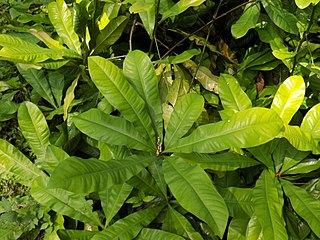
Ancistrocladus korupensis is a species of liana endemic to southwestern Cameroon and the neighbouring regions of Nigeria. The type locality is Korup National Park. The plant was identified as new to science in 1993 after pharmacologically intriguing alkaloids were found in its leaves.





















